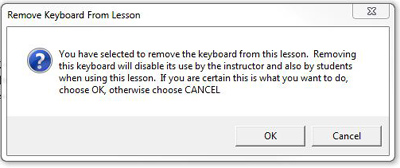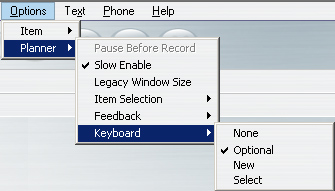Adding content to an item
Once an item has been created in a Planner, content (text, graphics, video, and sound) can be added.
Adding text
Text can be entered in Teach, Answer, Read/Record, Example, Verify, Simultaneous, Multiple-Choice and Fill in the Blanks items.
NOTES
Instruction, Write and Conversation items do not display text to the students.
Any text entered in any of these 3 last items will simply be ignored and not displayed in the student's interface.
...
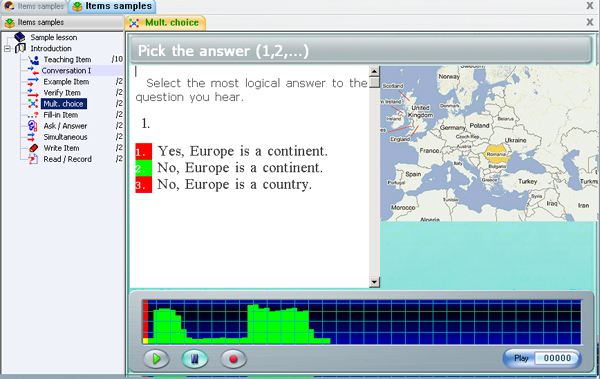
The text is displayed in a rectangular screen window. The size of the window depends on the type of the item and the presence of an imported graphic.
If an image is imported in an Example, Simultaneous, or Verify the text display window is reduced to 3 lines. However, more text can be entered, and if so, the text can be viewed by scrolling down.
There are several ways to enter text:
Entering Text Using the Machine's Keyboard
Characters that are typed in are inserted at the text cursor position. Click on the text area to show the cursor and type your text. All the normal display characters can be entered from the keyboard.
- If your machine has several language input methods installed, select your keyboard language prior to typing in CAN-8.
- For cursive Arabic or languages that read from right to left, you will have to the text option before you start typing. These options are in the top menu of the interface under TEXT

- The cursor keys (Up, Down, Left, Right) move the text cursor in the window.
- The Home and End keys move to the start and end of the current line in the text window.
- CTRL + C to copy selected text, CTRL + V to paste it, CTRL + X to cut it.
- The character at the text cursor can be deleted with the Del key.
- The character to the left of the text cursor can be deleted with the Backspace key.
- If the text cursor is at the beginning of a text line when the Backspace key is pressed, the line is joined to previous line.
- Lines that would be too long to fit in the window are broken at a word boundary and continued on the next line.
Some languages require a few accented or specific characters. These characters are available in CAN-8 if they are not present in your keyboard and can be accessed using one of 2 methods:
Method 1:
Type the character and then use CTRL + A on the keyboard to cycle through various alternatives for that character.
Method 2:
- Type a character then right click on the typed character.
-
Select Accent in the popup menu.
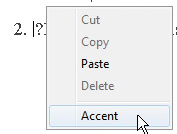
-
A list of alternative characters will display. Click on the character in the popup selection box.

Entering Text Using a Virtual Keyboard
In other languages where the standard keyboard may not contain the characters needed, the course author may define a virtual keyboard that contains the required characters.
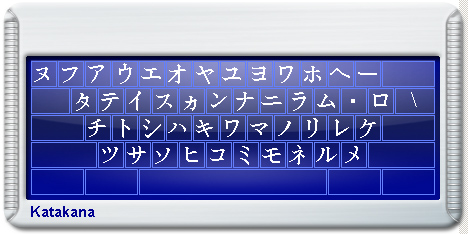
CAN-8 comes with 20 pre-defined keyboards and a template that allows you to create your own. Pre-defined keyboards can be selected and used as they are to create an activity, or can be edited to suit the need or layout that the instructor may prefer.
When a Virtual Keyboard is added to an activity, the instructor has the option to enter text from the physical OR the virtual Keyboard, and thus can use both sets of characters.
The user toggles between these keyboards by either clicking on the Virtual Keyboard interface to activate it, or on the text area to de-activate it. While deactivated, the Virtual Keyboard is semi-transparent.
When the virtual keyboard is activated, each key is linked to the corresponding key on the physical keyboard. Therefore, the user can type in the language of the virtual keyboard using the machine's physical keyboard.
The user can also enter text by clicking on the desired character key on the virtual keyboard using the mouse.
When using the Virtual Keyboard an accented or alternative version of a character can be entered using the following method:
- right click on the keyboard key
-
then select the character variation you wish to type.
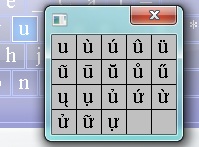
For information regarding the creation or editing of virtual keyboards and how to make them part of an activity or how to save them on the server please read the Virtual Keyboard section of this document.
Importing text from a file
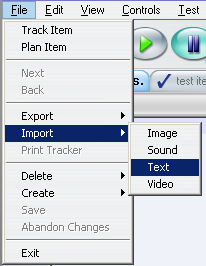
Located under the File Menu, the Import > Text option allows you to import the content of a text file located either on the local drive, a network share or a removable data storage device.
NOTES
- This method only applies to files with the extension .txt. You cannot import a .doc or a .pdf file.
- Text fonts not supported by CAN-8 will be replaced by CAN-8 the default font when importing.
-
If you wish to preserve the size of the text as it was in the copied document, select this option in the Planner tab of your Preference window :
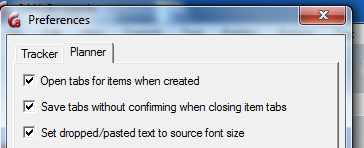
...
Adding text using drag/drop
Text can also be entered by selecting and dragging the content (or a section) of a file directly in the item.
You can drag/drop text:
- From a CAN-8 item to a different place in the same CAN-8 item
- From a CAN-8 item to another item in the same Planner
- From a CAN-8 item in a Planner to an item in a different Planner
- From any word processor document (.DOC, .PDF etc...) into a CAN-8 item as long as the word processor support the drag/drop function.
- From a browser (Explorer, Firefox...) into a CAN-8 item
- open the document, CAN-8 tab or web page you want to copy some text from,
- drag the mouse over the text while holding the left mouse button to select it,
- release the left mouse button and move the mouse pointer over the selected area,
- press the left mouse button again and hold it pressed then move the mouse pointer to where you want to drop the text,
- with the left button still pressed, hold the mouse over the CAN-8 Item's tab to activate and display the item,
- release the mouse button where you wish to place the text.
If the document you wish to drag text from and the CAN-8 interface are tiled next to each other on your screen,
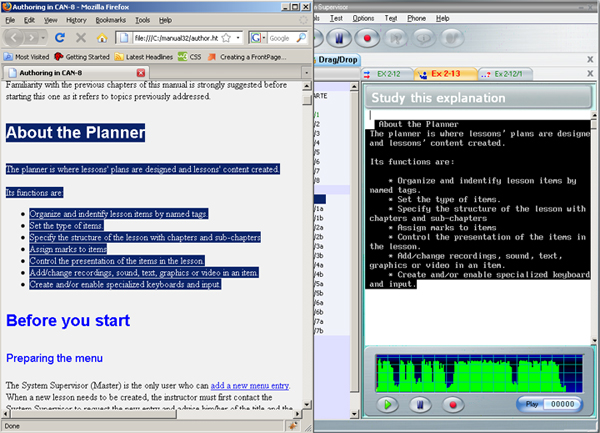
- Select the text in the document.
- While pressing the mouse button, drag directly from the document into the text area of the item in CAN-8.
- Release the mouse button to drop the text
If both interfaces (CAN-8 and the word editor or browser) are layered on the screen one above the other:
- Select the text with the mouse.
- left click on the selected text holding the mouse button down.
-
Drag the mouse cursor
 over the CAN-8 icon or tab in the task bar and hold it there until the CAN-8 interface displays on your screen.
over the CAN-8 icon or tab in the task bar and hold it there until the CAN-8 interface displays on your screen.

- Place the cursor over the item tab in the CAN-8 system you wish to drop the text into if it is not already displayed.
- Finally drag the mouse pointer into the text area of the CAN-8 item and release the mouse button. A copy of the selected text will appear.
To drag/drop text from an item to another item in the same Planner:
- Select the text.
- Drag it over the item tab you wish to drop it in.
- The item will then display, and you can place the drag cursor where the text should be dropped.
- Release the mouse button to drop the text.
To drag/drop text from a Planner to another Planner
- Select the text.
- Drag it over the Planner tab you wish to drop it in and hold it there until the target Planner displays.
- Still pressing the mouse button down, hold the cursor over the item tab you wish to drop the text in and hold it there until the item displays.
- Place the drop cursor where you want the text.
- Release the mouse button.
NOTES
- Text font not supported by CAN-8 will be replaced by CAN-8 default font when dropping.
- Some websites do not support drag/drop of their content. Instead of the selected text being dropped, you will see the URL (http://...). If this is the case, use the copy/paste method.
-
If you wish to preserve the size of the text as it was in the copied document, select this option in the Planner tab of your Preference window:

...
Copy > Paste text from a document or browser
Text can also be entered by selecting and copying the content (or a section) of a file and pasting it in the item.
You can copy/paste text:
- From a CAN-8 item to a different place in the same CAN-8 item
- From a CAN-8 item to another item in the same Planner
- From a CAN-8 item in a Planner to an item in a different Planner
- From any word processor document (.DOC, .PDF etc...) into a CAN-8 item.
- From a browser (Explorer, Firefox...) into a CAN-8 item if the website allows their content to be copied.
- Open the document, CAN-8 tab or web page you want to copy some text from,
- drag the mouse over the text while holding the left mouse button to select it,
- release the left mouse button and move the mouse pointer over the highlighted area,
- press the right mouse button to open the contextual menu and select copy or use the CTRL + C keyboard shortcut.
- click on the CAN-8 item you wish to paste the text in at the position you want the text to show.
- you can then right click and select paste, go to Edit > Paste from the top menu or use the CTRL + V keyboard shortcut.
NOTES
- Text font not supported by CAN-8 will be replaced by CAN-8 default font when pasting.
- Some websites do not allow their content to be copied. You will not be able to select the text you wish to copy.
-
If you wish to preserve the size of the text as it was in the copied document, select this option in the Planner tab of your Preference window:

...
Editing/Formatting Text
Special tools for editing text are found under the Text menu and the Edit menu in the top menu bar.
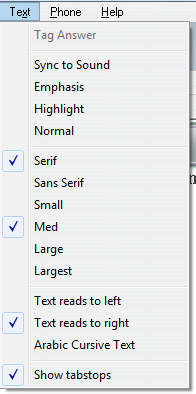
Text may be altered by selecting the text with the mouse (dragging the cursor over the text or a portion of it) and selecting an edit function. In this manner text can be cut, font size changed, type of font altered, and text deleted.
-
Sync and colour options.

In the first section of this menu, the 3 first functions relate to text/audio synchronization or are used when creating Multiple-Choice questions and fill in the blank questions. Their use is detailed in the section related to these items.
To draw attention to a specific part of the text, a word, a sentence, or part of a word, you can highlight it to make it stand out:

To do so, place the text cursor at the start of a word and then, select Highlight. The word to the next space will be displayed in green.
Alternatively, drag the mouse over a sentence or a text section and select Highlight to have that section highlighted

-
Font type and size.
 By default, the text typed pasted or dropped in a new item is set to medium serif.
You can however change the choice of font, the font size and the text direction before typing.
By default, the text typed pasted or dropped in a new item is set to medium serif.
You can however change the choice of font, the font size and the text direction before typing.
There are several text sizes to choose from as well as 2 types of fonts (Serif and San Serif).
-
Text direction

In some languages text is written from right to left. Select the to left option in the Text menu to orient the cursor and the text flow direction for writing in these languages.
This section also offers an Arabic Cursive Text option. This option is unique to Arabic-like languages and has no effect on any other language other than to align the writing to the left.
In Arabic-like languages however this option formats the proper cursive script display, as Arabic character vary depending on the character directly before or after them.
-
Show Tab stops
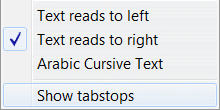
Is used to change the default size of the Tab. It can be used for example when creating a table with columns of different width.
- Select Show Tab stops
- A blue vertical cursor will show at the left edge of the text area
- Drag the blue cursor to where you wish the first column to start
- Repeat this step for as many times as columns you want to create.
- Once these tab stops are in place you can move the text cursor from one tab to the next by simply using the Tab key of your keyboard.
Adding a recording or an audio file.
Sound can be added in any of the available items but will be displayed or will behave differently depending on the item type.
To add audio in CAN-8, you can:
NOTES
- The maximum length for a recording or an audio file in an item is 40 minutes.
- Sound files in .wav, .mp3 and certain .wma format can be imported into the CAN-8 system. The .wav audio format must be PCM at 44.1, 22.5 or 11.25 KHz.
- Although you may grab files from a CD ROM, they have to be in a supported format. Native CDA files as found on regular audio CD disks cannot be dropped into CAN-8. You will need to convert them in a supported format first.
...
As sound is recorded or imported, a volume graph (in green) is drawn across the screen.

The volume graph shows the loudness of the recorded sound. This helps in judging how loud to speak or in adjusting the playback volume of other sound sources which might be attached to the sound input of the computer.
The sound recorded should come close to the top of the graph but should not touch the top. This causes a distortion that sounds like a loud click in the recorded audio.
The volume graph is useful in achieving a consistent level of recorded sound across multiple items. Once the student has adjusted the play volume at the start of an activity, it will not have to be changed again for each item.
The volume graph also helps the course author locate the beginning of words when synchronizing text and sound.
Recording sound with a microphone
NOTES
When recording from a microphone:
- Always use a good quality microphone.
- Ensure the environment you are recording in is quiet.
- Place the microphone as far as possible from the computer to minimize machine noise from fans or other devices.
- While recording, observe the volume graph and ensure that the green sound graph reaches approximately three quarters of the total height of the grid during loud parts. Adjust the microphone settings if the recording is too loud and the green audio graph touches the top or move the microphone away from you.
- Review and edit the recording to minimize pauses and noises at the beginning and end of the green graph.
...
To start recording, select one of the 3 options:
-
 Press the Record button. The same record button is available from the interface main menu bar, or from the volume graph button bar.
Press the Record button. The same record button is available from the interface main menu bar, or from the volume graph button bar.
-
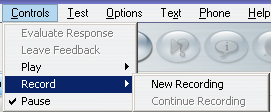
You may also use the RECORD option under Controls in the menu bar:
- New Recording: Starts a new recording. Will erase any previous recordings made.
- Continue Recording. Will append recording to the existing recording
- use the F3 key from the keyboard.
To stop recording:
-
Press any Pause button available on the screen.
- Select the Pause option under the Controls menu.
- Press the F4 key on your keyboard.
-
Recordings can be resumed by pressing
- the F3 or F4 key
- Selecting> the Continue Recording option under Controls > Record top menu
Importing Audio Files
NOTES
You can import audio files in WAV, MP3 and WMA format. Native CDA files, as found on regular audio CD disks, cannot be imported into CAN-8. You will have to convert them first using a software such a Windows Media Player.
...
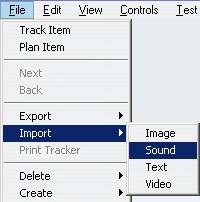
To import an existing sound file directly into CAN-8 select Import --> Sound from the File option in the menu bar. A file selection dialog will allow you to browse to the location of the sound file you wish to import.
The imported sound file will be appended to the end of any currently recorded sound shown in the volume graph.
Drag/Drop Audio Files
Sound files in WAV, MP3, WMA can be dragged and dropped into the CAN-8 system.
NOTES
Native CDA files, as found on regular audio CD disks, cannot be dropped into CAN-8. You will have to convert them first using a software such a Windows Media Player.
...
1 - If your open windows are tiled:
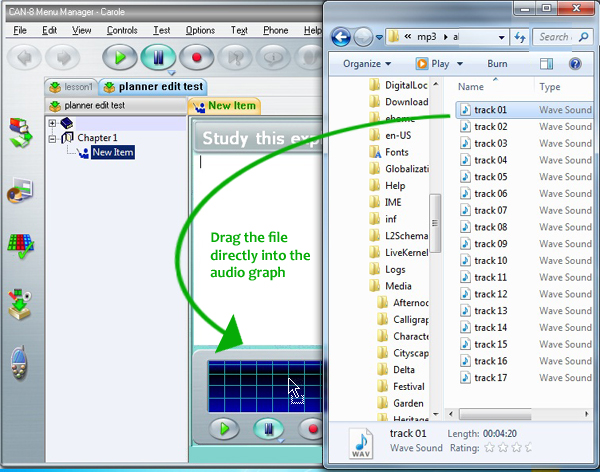
- Locate the file you wish to import into CAN-8.
- Click once on it to select it - do not release the mouse button.
- While holding the button down, move the mouse cursor on to the item's sound graph.
- Release the mouse button to drop the file.
2 - If your windows are superimposed.
- Locate the file you wish to import into CAN-8.
- Click once on it to select it - do not release the mouse button.
-
Move the mouse cursor so that it is on top of the CAN-8 icon showing in your task bar.
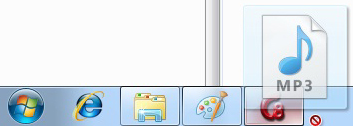
- Hold it there for a few seconds - this will display the CAN-8 interface.
-
Without releasing the mouse button, move the mouse cursor so that it is either on top of the desired item tab in the Planner interface, or directly into the audio graph if the item is opened as illustrated in the previous example

- Release the mouse button to drop it.
The audio can also be dropped into the Planner treeview menu which will create a disabled item containing the audio.
3 - If the audio is located in a CAN-8 item.
WARNING
This method does not copy the sound section, it clips the selected part of the audio and places it in the other item.
...
- Open the item that contains the original audio.
- Place the mouse cursor at the start of the audio section to clip and right click.
-
Hold the mouse button down while dragging the mouse across the sound graph to the end of the audio section you wish to move. As you move the mouse the selected audio is shown in dark green.

- Release the mouse button. The sound section selected remains dark green.
- Left click once on that section, holding the mouse button down. (If you click but release the mouse button, the selection will be cancelled)
- Drag the selection over to the item tab you wish to place the sound in. Hold the mouse over the tab until the item's interface is displayed.
- Move the mouse cursor to the volume graph and release the mouse button.
- The sound section will appear in the Volume graph at the location selected.
Copy/Paste or Cut/Paste sound
1 - To copy an audio file from a drive
- Locate a file on your drive, then right click on it to get the contextual menu, or left click once on it and select the EDIT option in the menu bar.
-
Select Copy or Cut
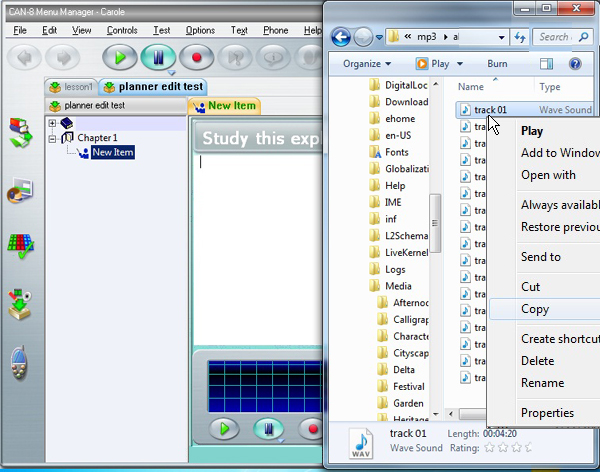
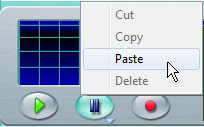
- Place your mouse over the volume graph window in CAN-8.
- Right click and select PASTE in the popup menu, or select EDIT > PASTE in the menu bar of the CAN-8 interface.
- Place your mouse over the volume graph window in CAN-8.
2 - To copy or cut a portion or all of the audio located in another CAN-8 item:
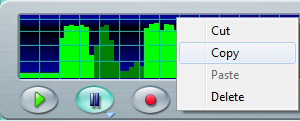
- Open the item you want to copy or cut the audio from.
- In the volume graph, click at the beginning of the sound you wish to copy, hold the mouse button down while dragging the mouse cursor to the end of the audio section you want.
- The section selected will be displayed in a darker green.
- Right click on the selected section and choose COPY or CUT from the popup menu. Alternatively, you can select EDIT > COPY (CUT) from the CAN-8 interface menu bar.

- Open the item you wish to paste the sound in.
- Right click on the volume graph at the location you wish to place the sound and select PASTE in the popup menu. If you do not care where in the volume graph the audio is placed, you may also choose EDIT > PASTE from the CAN-8 interface menu bar.
Playing Sound
1 - To play the recorded or imported audio:
-
Press the Play button located in the button bar or on the volume graph.

- You can select one of the Play options under Controls in the top menu.
- You can also press the F2 key of the keyboard.
- And finally, you can play the audio by double clicking on the volume graph
As the sound is played, the play cursor line (red and yellow) moves across the sound volume display.
2 - To pause the sound at a specific place:
-
Press the Pause button.

- Select the Pause option under Controls in the menu bar.
- Press the F4 key on your keyboard.
3 - Playing can be resumed by:
- Pressing the Pause button or the Play button again.
- Selecting the Play option under Controls in the menu bar.
- Pressing the F2 or F4 key on the keyboard.
Editing Sound
There are several reasons for editing sound. In many cases the microphone used for recording picks up the sound of keys on the keyboard or the sound of taking a breath before speaking and you may want to remove these noises.
There might also be a need to remove part of an audio file or to split an existing audio file to create several items.
In almost all cases it will be necessary to edit the audio that has been recorded or imported in order to create a good quality activity.
The audio is edited using the volume display and the mouse. The primary method of editing audio is to remove unwanted parts, or to move sections of audio from the current item to another item. How to move sound from one item to another was covered in the Drag/Drop Audio Files chapter. The following section details how to remove unwanted sound:
- Locate in the volume graph the part of the sound you wish to remove. You can locate it visually, or you can use the counter situated at the bottom right of the volume graph.

- Click at the beginning of the section to be removed, hold down the mouse button on the volume display, then drag the mouse across the volume graph till the end of the section, leaving behind a darkened area. This area marks the sound to be removed. The sound to keep remains in bright green.
- Delete that section using the DEL or Backspace key of the keyboard, or by selecting the Snip option under EDIT in the top menu. The dark green highlighted section of the sound will be removed.
When possible, the sound should be cut at quiet parts indicated by an area in the graph with the lowest possible height. If the sound is cut during loud sections, clicking sounds may result in the final sound where the remaining parts joined.
Synchronizing Text and Sound
Synchronizing the text and the sound builds links between the words in the text window and the sound in the volume display. As the sound plays, the corresponding synchronized words in the text are highlighted in turn. When the audio graph is clicked on, the sound starts playing from that point and the synchronized words display from that location in the sound. Likewise, clicking on the synchronized text plays the corresponding audio from that point on.

Any text can be synchronized, from single letters and spaces, syllables and words to entire line of text.
NOTES
Synchronization establishes a one to one correspondence between the text and the sound. The chronological order of the sound must be maintained in the text:
- It is not possible to synchronize the text from beginning to end with the audio from end to beginning.
- It is also not possible to synchronize a word in the text to more than one different place in the sound display. The word must be repeated twice in the text to be synchronized to two occurrences in the sound.
...
The procedure below must be executed in the exact order given.
To synchronize the text:
- Locate in the audio graph the sound you wish to synchronize possibly by re-playing the audio until you can see where in the graph the word you want to synchronize is located. The graph counter may be helpful to remember the exact position of the audio.
- In the text area, click in front of the word or text to be synchronized
- Click on the volume graph where the matching word begins.
- Select TEXT > SYNC TO SOUND in the top menu. The text will highlight in cyan to the end of the line.
- Repeat these steps for each word/sentence you wish to synchronize.
If you wish to synchronize a syllable, or part of a word, select the syllable by dragging the mouse over, then follow the remaining steps to synchronize.
Repeat steps 2 to 5 as many times as you need while proceeding in a forward direction (left to right, beginning to end) through the text and audio.
Synchronizing is done a line at a time. It is not possible to go backwards and synchronize words that appeared before the last synchronized word.
NOTES
To remove text synchronization, select EDIT > CLEAR > SYNC in the top menu.
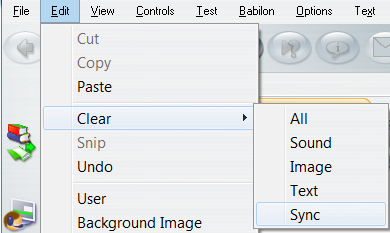
...
Emphasized text
The TEXT > EMPHASIS option, like the SYNC TO SOUND option, also establishes a one to one correspondence between the text and the sound in a chronological order.
Similar to the Synchronize to Sound option, the user can click on the text to hear the corresponding sound, or click on the audio graph to view the corresponding word.
The procedure to link the audio and corresponding text is similar to the procedure used to synchronize them, and the conditions are the same.
- Locate in the audio graph the sound you wish to emphasize possibly by re-playing the audio until you can see where in the graph the word you want to synchronize is located. The graph counter may be helpful to remember the exact position of the audio.
- In the text area, click in front of the word or text
- Click on the volume graph where the matching word begins.
- Select TEXT > Emphasis in the top menu. The text will highlight in red to the end of the line.
- Repeat these steps for each word/sentence you wish to emphasize.
When the text is emphasized and the corresponding audio is playing in the student program, the text is displayed in red font and highlighted yellow. However, contrarily to the synchronized text that returns to its original black font when the synchronization has moved over, once the emphasis highlight has moved on to another part of the text, the previously emphasized text remains in red font.


NOTES
To remove text emphasis select EDIT > CLEAR > SYNC in the top menu.

...
Adding Graphics
A graphic can be imported and displayed as part of the content of an item or as a background for an activity.
The graphic must be a JPG, BMP or a GIF (stored in the GIF 87 format). GIF files must not be of the interlaced type. If the graphic is in some other format, it must be converted to a supported format using a conversion utility or a drawing package.
Images are restricted to a maximum size of 320 pixels horizontally and 240 vertically. Images sized 320X240 will display entirely. Larger sizes images will be cropped to these dimensions and thus only the top left corner will be displayed while the rest is discarded.
There are different options to import graphics:
- Use the Import function from the menu.
- Drag and drop a file from a disk, a browser or another CAN-8 item.
- Copy/paste the image from a browser, a file or another CAN-8 item.
Importing images
To import an image, access the File option from the menu bar, select Import and then Image
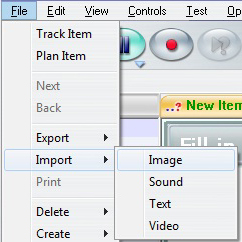
NOTE
You must open a Planner and an item first or this option will be greyed out.
...
"
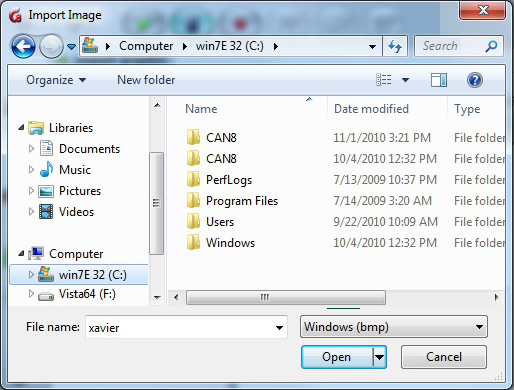
The import image window allows you to browse for the file of your choice.
It may be necessary to use the drop-down menu to select the appropriate file type.

Once the file is selected, it will display in the item.
Drag/drop Image
You can drag and drop an image directly into a CAN-8 item.
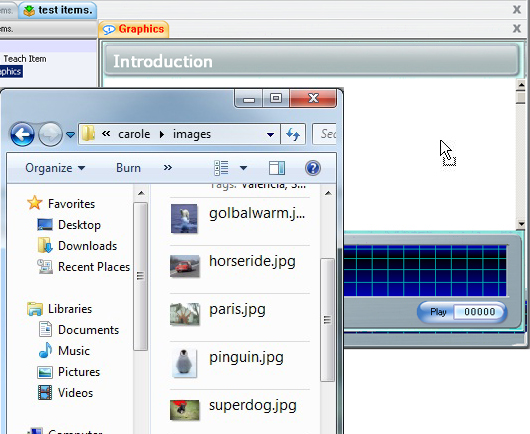
- Locate the image file on the disk or removable storage device, click once on the image to select it, and while holding the mouse button down, move the mouse cursor over the CAN-8 interface as illustrated.
- Release the mouse button to drop the image in the item.
- The same steps are used to drag/drop an image from a browser. Simply select the image by clicking once on it, then while holding the button down, move the mouse cursor over to the CAN-8 interface and the CAN-8 item, then release the mouse button. The image will appear.
NOTES
- The image is always pasted in the graphic area, independently of where the cursor is placed.
- When dragging a file from an internet browser, the file has to fit the size and format requirements.
- Some websites will not allow their images to be dragged. When attempting to drop them, you will instead obtain the URL pointing to the image (http://www.website.com/.../)
- Once the image is dropped into a CAN-8 item, it is then converted into CAN-8 format and saved in the item file. The original is no longer required.
...
Copy/paste Image
An image can be copied then pasted from either a file on the hard drive or removable data storage device, or from a browser.
- Locate the graphic you would like to place in your item.
- Right click on it and select copy in the contextual menu.
- In the CAN-8 interface, select the item you wish to paste the image in by having it displayed on the screen
- Right click on the displayed item and select Paste from the popup menu.
Alternative methods can be used, such as:
- EDIT > COPY in your browser, or your explorer menu bar, then EDIT > PASTE in CAN-8.
- CTRL + C on your keyboard to select the image and CTRL + V to paste it in your other item.
NOTES
- The image is always pasted in the graphic area, independently of where the cursor is placed.
- When pasting a file from an internet browser, the file has to fit the size and format requirements.
- Once the image is dropped into a CAN-8 item, it is then converted into CAN-8 format and saved in the item file. The original is no longer required.
- You can COPY/PASTE an image from another CAN-8 item using the same procedure.
...
Link a video file to an item
This section describes how to play video as a part of a CAN-8 item, the requirements, and file formats.
Video File Types
NOTES
Each device used to record a video uses a different method of compression. As a result, the proper codecs must be installed on the workstation in order to play the video. This is the most common problem encountered when playing video on a computer.
...
Both MPEG and AVI files can be linked in a CAN-8 item, each with their own points of merit.
AVI Files
AVI files tend to have a wider range of codecs that are used in their compression. This means that it is sometimes a challenge to ensure that all workstations are equipped with the proper codecs for playing the activity. The newer Microsoft OS however do have most of these CODECs installed by default`w
MPEG Files
Most machines will have the needed MPEG codecs already installed. MPEG files tend to be compressed more efficiently and therefore may have a more consistent delivery when being played by large groups of students simultaneously.
Variants of MPEG (specifically MPEG-4, but others as well) may also be stored in an AVI file using the correct codecs.
Linking video files
NOTES
- Unlike sound or picture files, video files are not imported in CAN-8 and therefore are not converted in CAN-8 format. The original video must be present on the machine, the network or the website it was linked from and students must have access to this location from their workstation.
- Videos will have an impact on the network bandwidth. For an optimal experience, favour shorter videos.
...
To link a video:
- File > Import > Video from the CAN-8 menu bar.
- File > Import> > Video via URL from the CAN-8 menu bar.
- Drag and drop from a shared folder.
- Copy/Paste from a shared folder.
From the File > Import > Video Menu
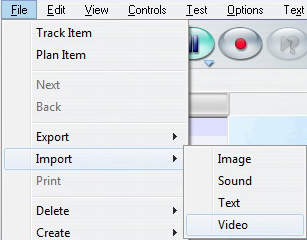
If the video is located on on a shared network folder:
- Access the File option from the menu bar in the Recorder and select Import > video
- In the Video Import box, select the file type (avi, mpeg or wmv).
- Browse and select the file to link to.
NOTES
- The video will only play if the student connects from within the school's network.
-
If the path from the instructor station is:
W:\video\file.avi
Where W:\ is a network share, and Video a shared folder, this path, including the drive letter, has to exist on ALL client machines that will be accessing that activity.
- If the video is on your C:\drive, the video will not play on the student station unless you place a copy of the video on their C:\drive, in the exact same path as yours
...
From the File > Import > Video from URL Menu
The file will be played from a webserver instead of a local server and is accessible to all remote users.
For remote users, this would be the most effective way to add a video as all students will be able to access the video URL.
-
In File option from the menu bar, select Import > video from URL

In the Select URL box, type or paste the full URL where the file is located. (i.e.: http://www.mywebpage.com/video/myvideo.mpg). You must type in the http:// header
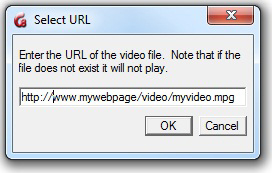
- Select OK.
NOTES
The remote users' stations must have the proper CODECs installed. It is therefore preferable to format the video with CODECS that are already included in the Microsoft OS.
...
Drag and drop from a shared folder
- Browse through the folder and locate the file. Make sure the file is of the correct format.
- Click on the file, and while holding the mouse button down, drag the file either directly into the CAN-8 item if the software is tiled, or on top of the CAN-8 icon in the task bar to open the CAN-8 interface.
- When the mouse cursor is over the item's text area, release the mouse button to drop the file.
NOTES
- This method will not work for remote users.
- The video will only play if the student connects from within the school's network.
-
If the path from the instructor station is:
W:\video\file.avi
where W:\ is a network share, and Video a shared folder, this path, including the drive letter, has to be existing on ALL client machines that will be accessing that activity.
- If the video is on your C:\drive, the video will not play on the student station unless you place a copy of the video on their C:\drive, in the exact same path as yours
...
Copy/Paste from a shared folder
- Browse through the folder and locate the file. Make sure the file is of the correct format.
- Right click on the file and select Copy or select EDIT > COPY from your menu.
- Open the CAN-8 interface.
- Place the cursor in the text area of the item, right click and select Paste or select EDIT > PASTE from the menu bar.
NOTES
- This method will not work for remote users.
-
If the path from the instructor station is:
W:\video\file.avi
where W:\ is a network share, and Video a shared folder, this path, including the drive letter, has to be existing on ALL client machines that will be accessing that activity.
- If the video is on your C:\drive, the video will not play on the student station unless you place a copy of the video on their C:\drive, in the exact same path as yours
...
Delete Item Content
The content of an item can be deleted using the Clear option in the Edit menu. This will not delete the item from the planner's menu.
The options are
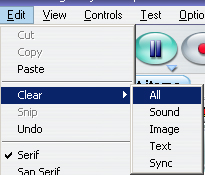
- Clear > All - Will clear all components of the item: audio, text, image, and video.
-
Clear > Sound -
All audio components are removed from the item. If the item includes an AVI, the audio component of the video will be deleted, the graphic part will remain.
- Clear > Image - Will delete any graphic the item has. If the item includes a video, this option will remove the graphic component, but the audio part will remain.
- Clear > Text - The text is removed from the item.
- Clear > SYNC - Deletes the link between the text and the audio when it has been synchronized. The text and the audio remain untouched.
Alternatively, text and audio components can be deleted by dragging the mouse over to select it, then pressing the Delete key.
Graphics and Synchronization however can only be deleted using the Clear menu option.
NOTES
- If a video has been imported in the item, it is possible to delete the audio part of the video, and keep only the graphic part, or vice versa.
- If the audio of a video is deleted, then replaced by another recording, the graphic part of the video will play while playing the new audio.
...
Save Item Content
Any changes related to the content of an item must be saved or abandoned when exiting each item.
NOTES
Saving the content of the item allows you to close the item tab without losing the changes you made to an item. It is done locally and is not available to the students nor is it saved on the server.
The content will only be available to the students once the Planner is saved.
...
By default, when exiting the tab of an item that has been edited, a Save / Abandon Change option is presented:
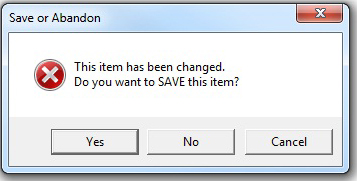
- YES: will save the changes to the item. You can reopen the item during the same session. The content is saved.
- NO will remove all changes that were done to the item since it was last saved. It does not delete the item from the tree menu. It only affects the content.
- CANCEL or EXIT will simply abort the EXIT request. The item remains open; the content is kept the way it was on the screen now.
The default setting can be changed to skip these prompts. The Items will then automatically be saved to include the last changes when the user closes the tab. The option to abandon the changes to an item will still be available from the File > Abandon Changes link in the top menu.
The steps to change these defaults are detailed in the user's preferences section of this chapter.
NOTES
-
This prompt is not shown if the item has not been changed prior to exiting the item.
- If, when exiting the Planner, you select Abandon Changes, the changes to the items you saved will also be abandoned. The planner will return to its original state before you made any changes to the items.
...
Item Types
An instructor can create up to 11 different types of items, although two of these item types only modify the behaviour of the item that follows directly in the plan (Introduction and Conversation item).
The format of each item is pre-defined and can include different components, like audio, text, graphics, and video. We will address the components of each of these items all throughout this next section as we go through the creation process and details of each item type.
The Introduction Item (I) 

May include: audio, graphic
Does not display text
Does not display an interface to the student.
Requires no recordable or written input from student.
In the Introduction item, an oral introduction may be recorded. This recording is then played first whenever the activity is started or a new section of the activity plan entered.

Introduction items are used to divide the activity into sections, and are represented in the treeview of the activity as submenus. They can be created without content.
This item's behaviour will change depending on the content that it includes.
- If no content is added, this item is used to divide the activity into sections or chapters.
- If only audio is added, the audio plays when the student enters the activity or enters a new section in the plan, but no interface is presented.
-
Since this Item is transparent to the student and has no displayed interface, any text entered in that item is ignored in the student program.
- If a graphic is imported into this item (.gif .jpg or .bmp 320x240 pixels in size) it will become the background image for the all the following items, until either the end of the activity, or until another Introduction with a different image is encountered.
The screenshot below shows an introduction item in the planner that includes graphic, text and audio.
Click on the image to view the same item in student mode:
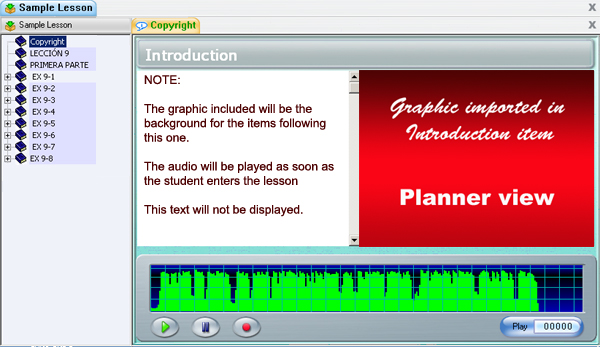
In the example above, the text present in the Planner (in the left panel of the work area) is no longer visible in student mode. The image is resized to the entire work area and will remain in the background for the rest of the section or until the end of the activity if the next Introduction item does not include an image.
This item's behaviour will also change depending on the content of the item that follows it directly.
- If the introduction item includes an image and one of the items following the introduction item also includes an image, the background image will be hidden to allow the item's image to stand out.
- If the introduction item includes an image, and one of the following items includes text, the background image is filtered to allow for more contrast.
- Since the introduction item has no interface in student mode, there is no volume graph for its audio. It plays automatically as the student starts the section.
The example below shows the impact of the same Introduction item as in the illustration above when it is followed by a teach item without graphic and when an image is added to that teach item
Click on the image to view the difference in student mode.

NOTES
Since students cannot submit an answer to this item, it does not have a corresponding cell in the tracker.
...
The Teach Item 
May include: audio, text, graphic or video
Requires no recordable input from student
A teach item explains a concept or gives instructions about the exercises that follow it. The recording screen for a teach item has a large text area and can display a graphic or video. The students cannot record nor type an answer in this item.
The screenshot below shows the Planner view of a Teach item with text audio and graphic.
Click on the image to view the same item in student mode:
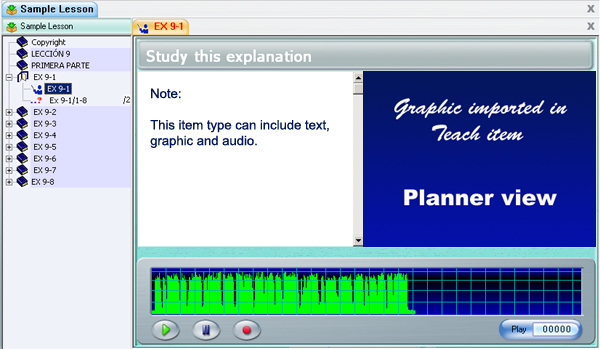
NOTES
Since students cannot submit an answer to this item, it does not have a corresponding cell in the tracker.
...
The Example Item 
Must include: audio
May include: text, graphic or video
Requires student to: Record an oral answer
In Example items, students listen to an example then record their own version of the example.
As 2 sound graphs are required for both the example and the students' own recordings, the text and graphic display area is limited.
The screenshot below shows an Example item in the planner with text audio and graphic.
Click on the image to view the same item in student mode:
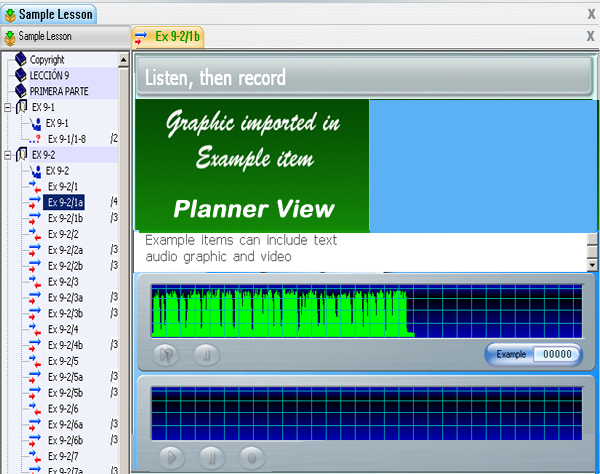
NOTES
-
When an image is imported in this item type,
The text display is reduced to 3 lines at a time. A scroll bar located on the right of the text area allows navigating through the remainder of the text.
- If no graphic is included, the text area expends to the regular text area size.
...
The Simultaneous Item 
Must include: audio
May include: text, graphic or video
Requires student to: Record an oral answer
The layout of the simultaneous item is exactly the same as the layout of the example item. It can include the same components, and also presents two volume graphs.
The students must record their answer while the example is played. They cannot listen to the instructor recording prior to their own recording time. As soon as the Record button is pressed, the instructor's pre-recorded audio is played and the student's recording begins.
The screenshot below shows the Planner view of a Simultaneous item with text audio and graphic.
click on the image below to view it in student mode.
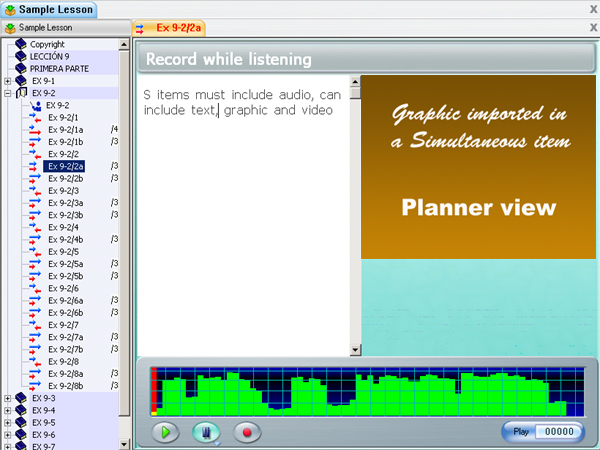
The Verify Item 
Must include: audio
May include: text, graphic or video
Requires student to: Record an oral answer
The screen for the Verify item is identical to the screen for the Example item.
As opposed to the Example item, students must first then verify their answer against the sample audio provided. The sample audio is disabled until the students first record their own answer.
The screenshot below shows the Planner view of a Verify item with text audio and graphic.
Click on the image to toggle between the Planner display and the student view of a Verify item.
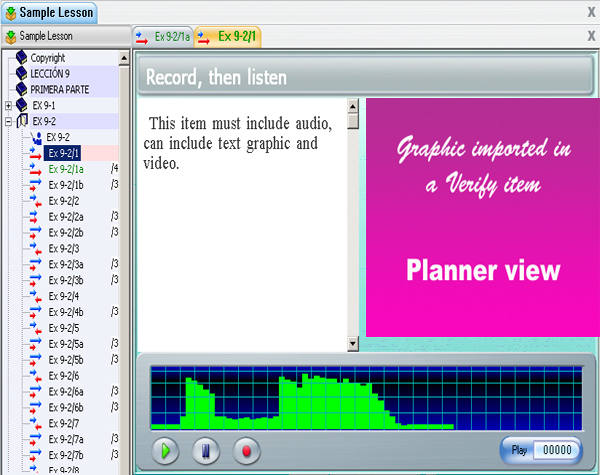
The Read and Record Item 
May include: text, graphic, video
The Read and Record item does not include audio, therefore no audio example or prompt is given to the students.
Although video can be added to a Read item only the visual part of the video will be played, the audio will be ignored.
The screenshot below shows the Planner view of a Read item with text and graphic.
Click on the illustration to toggle between the planner the student view of the same Read and Record item.

The Ask Item 
Must include: audio
May include: text, graphic, video
Requires student to: Record an oral answer
The Answer item requires the student to record an oral response to an oral question.
Unlike the Teach, Simultaneous, Example, and Verify items, the instructor's sample audio is not displayed to the student. The student can listen to the question again by selecting the example button.

The screenshot below shows the Planner view of an Answer item with text, audio and graphic.
Place the mouse cursor over the image to toggle between this view and the same item in student mode.
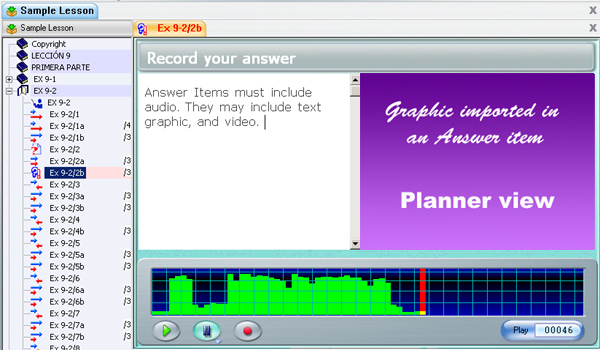
The Multiple-Choice Item 
Must include : text
May include: audio, graphic, video
Requires student to: Select an answer
in a Multiple-Choice item, students are required to select one of a number of written answers.
The text in a Multiple-Choice item consists of a question followed by a number of possible answers. the instructor can offer up to eight possible choices per question.
The instructor's audio sample can either repeat the question orally or present a recording or dialog that includes the correct answer(s) to the question.
The tutorial below details the procedure to create a Multiple-Choice item. Click on the Next and Back buttons to navigate.

|
|

|
|
|
|
Step 1 -
Type the question on the first line, then the answers on the following lines. Each answer should start on a separate line and can be more than one line
The maximum choices possible per item is 8, the minimum is 2. |
|
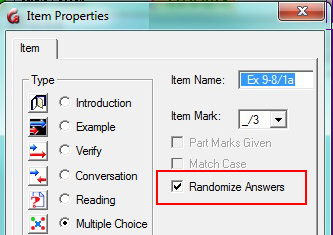
The available choices can be displayed to the student either in the order they were typed in or in a random order to prevent students from all having the same answers displayed and to add some challenge if the students are required to repeat the same exercises over.
By default, answers are randomized.
To remove the randomize option, open the item's properties box and remove the check mark in front of the Randomize Answers option.
NOTES
-
If you select to keep the Random option, do not add extra text under the last selected answer. Any line of text included below that last answers will also be randomized as part of the last answer and may be shown out of context.
LI> For this type of item, the computer will correct the student's answer. This item is visible from the Tracker screen and can be marked. If the student selects the correct answer, the computer awards the full mark. If incorrect, a mark of zero is awarded.
- In test mode, if no mark was assigned in the Planner to the a Multiple-Choice item, it will be treated as a practice question and feedback will be provided to the students unless you set the Planner's options to no feedback.
- If a mark has been assigned to the Multiple-Choice item in the Planner, there will be no feedback when in test mode.
...
The screenshot below shows the Planner view of a Multiple-Choice item with text, audio and graphic.
Move your mouse over the image to toggle between a Multiple-Choice item in the Planner and the same item in student mode.
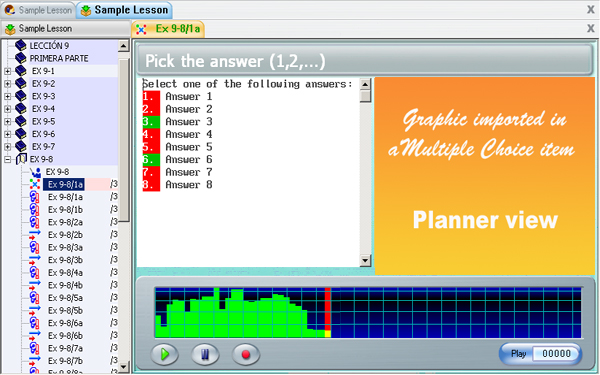
The Fill in the Blank Item 
Must include: text
May include: audio, graphic, video
Requires student to: Write an answer in the blanks provided.
This type of item must contain text. Part of the text is blanked out when it is displayed to the student. The student is required to fill in one or more highlighted blanks with the correct answer(s).
The tutorial below describes the procedure to create a Fill in the blank item
Click on the Next and Back buttons to navigate through the tutorial.

|

|
|
Step 1 -
To create this type of item, first type in the text, including the hidden text that specifies the correct answer. |
This item it is visible from the Tracker screen and can be marked. The computer will evaluate and score the student's answer. If a correct answer is entered, the computer awards the full mark. If incorrect, a mark of zero is awarded.
The instructor can at any time
change the mark assigned by the system from the Tracker.
It might be necessary that the case (upper or lower) of the text be respected as part of the answer. If in that item the upper case and lower case is considered important to the answer, select Match Case in the properties dialog of the item. When that option is checked, answers will be case sensitive. This option is off by default.
When marking a fill in the blank question that includes more than one blank, the computer can assign partial marks if the Part Marks option is checked in the properties dialog of the item.
NOTES
Part Marks and Match Case are set per item, not for the entire Planner. If all Fill-in items in a Planner must be case sensitive, this option will have to be checked in each of these items as they are created.
...
The screenshot below shows the Planner view of a Fill in item with text audio and graphic.
Place the mouse cursor over the image to toggle between the Planner and the student's view of the same item.
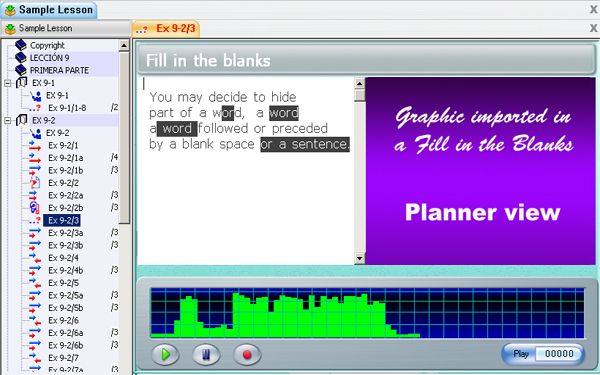
The Writing Item 
May include: audio, graphic, video
Requires student to: Type a written answer
This item does not display text to the students, only audio. Text entered by the instructor will be discarded in the student's interface.
The Writing item requires a written response from the student, either in answer to a dictation or to an open question. The recording button is deactivated in the student's interface since no recording can be made. The audio graph is present with the instructor's recording, thus allowing the student to listen to the instructions or the dictation over again. The audio playback can however be restricted to once, twice or three times via the item's properties.
The text submitted is available to the instructor through the Tracker and may be marked.
The screenshot below shows the Planner view of a Write item with text audio and graphic.
Place the mouse cursor over the image to toggle between The Planner's view and the Students' view of the same item.
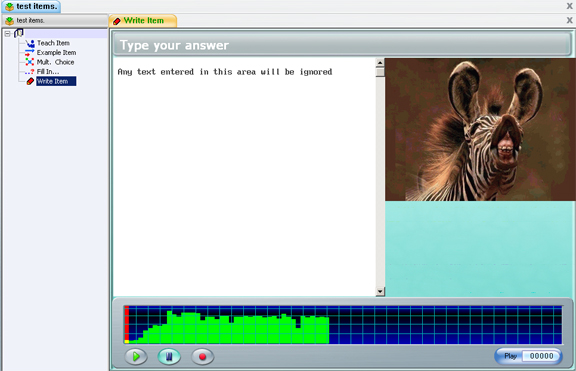
The Conversation Item (C) 
Must include: audio only
MUST be paired with an 'E' or a "V" item
Does not present an interface to the students.
The Conversation item can only contain audio and is not visible to the students (It has no interface). This item must be used in conjunction with Example or Verify items to form a dialog and can only be paired with either one of these 2 items types.
The Conversation item is used to play the first part of a conversation, the Example/Verify item that follows gives a suggested response or the correct answer. The Conversation item must therefore have sound, but graphics and text are ignored
the Conversation item does not show in the student menu. Only the name of the following Example or Verify item is listed as illustrated below:
| Conversation Items in Planner Menu |
View from the student menu |
 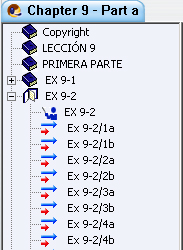 |
| Items titled 9.2/1, 9.2/2, 9.2/3 9.2/4 are Conversation items. They are paired with the items that follow directly (9.2/1a, 9.2/2a, ..., etc) They do not appear in the students' menu but will be played when the following Example items are selected |
NOTES
Since the student cannot record an answer in a Conversation item, this item is not visible on the Tracker screen; only the following Example item is shown and can be marked.
...
The Disabled Item
A disabled item is an item with an undefined type. Any item from a Planner can be disabled at any time.
NOTES
When an item is disabled, the menu entry and the content of the item are hidden from the students.
...
An item that has been disabled remains in the Planner's menu as is, unchanged, with the formatting of the text, audio and graphic untouched.
This item can later be re-assigned a type and will again appear in the student's menu as soon as the planner is saved.
Items that are created by dropping or pasting content (audio, images or text) directly in the Planner's menu are disabled by default.
You may disable items in a Planner for the purpose of hiding or showing different questions to different groups of students at different time.
To disable an item:
- Select the item in the Planner's menu
- Right click to bring the properties box
- At the bottom of the Item Types list, select disable
To assign a type to a disabled item, follow the same procedure as above, and select the type in the item types list.
The Item Properties
Item options are set on a per-item basis, therefore only affect the item they have been set for. Most are located in the Properties box of the item.
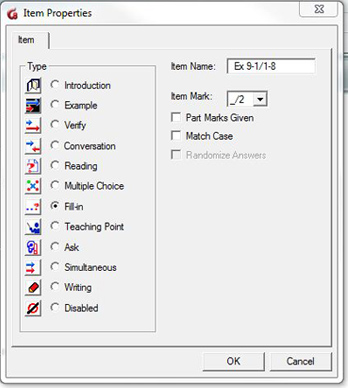
- Select the item.
- Right click on the item.
- In the pop-up menu, select Properties.
- The dialog as seen on the left will be displayed.
Some item options are specific to particular types, and are not available to all item types.
Item Types
This section lists all the type of items that can be created in a planner. You can change the type of the item by selecting the radio button in front of it. However, whereas changing an item from an example to a Verify or simultaneous item will not have much impact on the format of the item's content, changing it to a Multiple-Choice will require some work on the text to add the answer's options.
At the bottom of that list is the option to disable your item.
A disabled item remains in the Planner as is, unchanged, with the text, audio and graphic. It remains in the Planner's menu but is hidden from the students' menu
This item can later be re-assigned a type and will again appear in the student's menu as soon as the planner is saved.
When dragging or pasting content such as audio or text in the Planner's menu, a new item is created. It is however created without a type. You can leave it disabled and use it to create other items, or you can assign it a type and format it as needed.
Item Name
The title of the item at creation is New item. You can change its name right away, or click on it twice slowly in the menu to change it.
Alternatively, while changing the item's settings in the properties window, you can also change its name in the Item Name field.
Item Marks
This option is only available for items requiring a student answer, therefore is greyed out for Introduction, Teaching and Conversation Items.
When an activity is used for test purpose, it might be a requirement to score the tests. Although the correction of the item and the marking is done from the tracker, the mark the item will be scored out of is assigned per item in the Planner, in the item's properties box.
These settings can be added or changed at item creation or any other time by instructors. The Planner will have to be saved before they are applied.
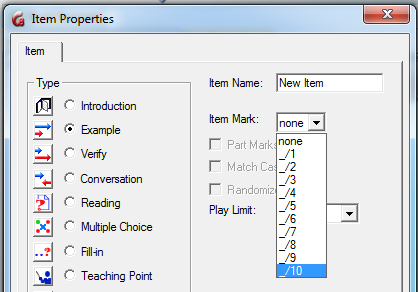
In the Item Mark field, in the right corner of the Properties box, select the mark the
item will be scored out of. These marks are pre-defined by the system.
_/8 means that this item will be scored out of 8 points.
Part marks Given
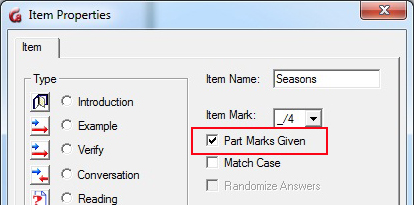
This option is only available for Fill-in-the-blank items. It is greyed out for all other items.
Fill-in-the-blank items are evaluated and scored by CAN-8.
By default, if the students submit a wrong answer to a Fill-in-the-blank item that includes more than one hidden word, the entire answer is considered incorrect and assigned a mark of 0.
This option however divides the final score for the item by the number of blanks in the question.
As an example, let's consider a Fill-in-the-blank item marked out of 3 (/3) with 3 words hidden; if the student makes a mistake in one of the blanks, by default the score for this item will be 0/3. If Part Mark given is checked, the score for the same answer will be 2/3
Since CAN-8 scores is rounded to an integer number, the results are more accurate if the instructor assigns a score for the item that is dividable by the number of blanks. For example, on an item with 3 blanks, assign _/3, _/6 or _/9 to have a more accurate score.
NOTES
- By default, the part mark option is off when items are created.
- This option is only available for Fill-in-the-blank items.
- Although Fill-in-the-blank and Multiple-Choice items are corrected by the system, instructors can overwrite the system mark in the Tracker and assign a different one.
...
Match case
This option is only available for Fill-in-the-blank items.
At certain times it may be important that the exact upper and lower case
characters be used to complete the answers in a Fill-in-the-blank question.
Fill-in-the-blank items are evaluated and scored by CAN-8. By default, upper- and lower-case are considered the same and will be
marked correct independently of the case used.
While this option is checked, correct answers will be case sensitive and
must match exactly.
Randomize answers
This option is only available for Multiple Choice items.
To prevent memorization or copying of answers, the available choices for
Multiple-Choice questions are normally randomized. This means
that each time a user enters the same exercise, the proposed answer will be displayed in a different order and each user taking the test at the same time will see the choices in a different order.
This option is on by default. To remove the option, uncheck it in the item's Properties Box. The item's choices will then always be given in the same order as designed in the Planner, each time the students encounter this question.
NOTES
- This is a per item option. It will only apply to the item the option is set in.
- Do not place additional text or characters below the last choice of the Multiple-Choice question in the Planner when using the Randomize Answer option, or the extra lines of text will also be randomized and will appear between 2 choices.
...
Play limit
This option limits the number of times the students can listen to the audio included in an item during a test. This option does not apply to activities set in practice mode.
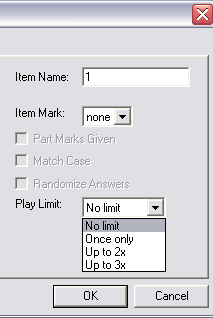
-
No limit is the default one. The student can listen to the audio in the item as many time as necessary
-
Once only limits the audio to one playback.
-
Up to 2X and up to 3X limits the pay back of the audio to 2 or 3 times (respectively) or less.
NOTES
- This option only applies when the activity is placed in TEST mode. In Practice and Review results mode, the student will be able to listen to the audio as many times as needed even if this option is set.
- During playback, the student cannot pause the audio, or go back to a part of the audio already played.
- If the text and sound are synchronized, the text will highlight when the sound is played, but clicking on the highlighted text will not replay the audio.
-
Once the limit of playback times has been reached, the student can no longer listen to that audio for the remainder of the test, even if the Back option is available and the student can visit that item again.
This audio is reset every time the student takes the test again.
- This option is available in all item types, including Instruction items.
...
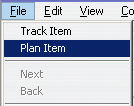














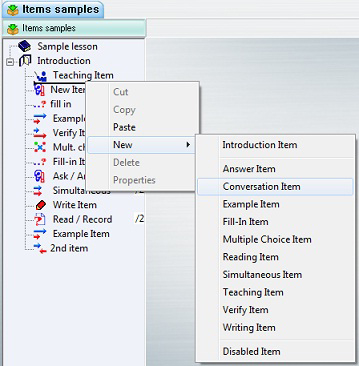



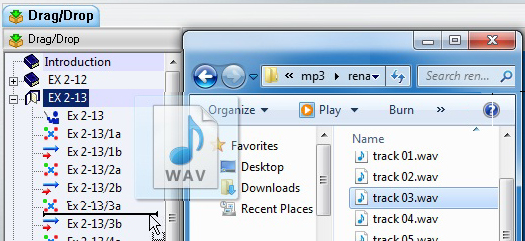
 Drop the file in the menu by releasing the mouse button. If the file is an audio file, as soon as the button is released, a mini volume graph window appears and displays the progress of importing the sound. For text files, the item is created directly.
Drop the file in the menu by releasing the mouse button. If the file is an audio file, as soon as the button is released, a mini volume graph window appears and displays the progress of importing the sound. For text files, the item is created directly.
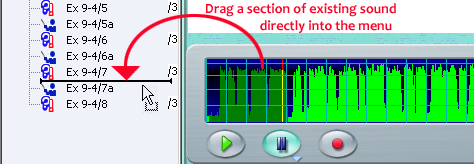
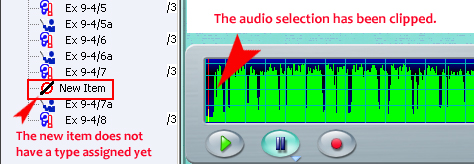
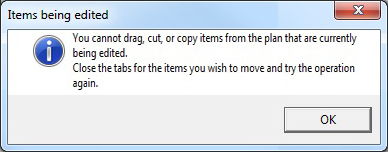

 The insertion bar will appear under the item and popup menu is presented.
The insertion bar will appear under the item and popup menu is presented.



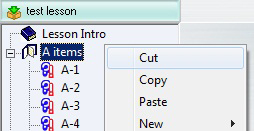
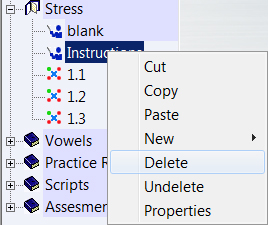

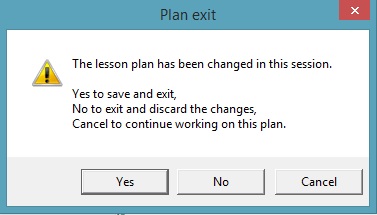

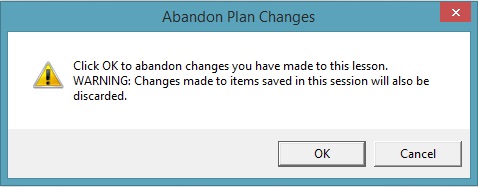













 : Saved without changes.
: Saved without changes.
 :
Saved with changes.
:
Saved with changes.
 : Empty item.
: Empty item.
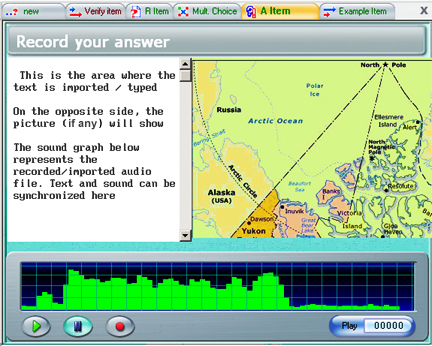

 A red cursor:
A red cursor:  The graph
The graph 










 over the CAN-8 icon or tab in the task bar and hold it there until the CAN-8 interface displays on your screen.
over the CAN-8 icon or tab in the task bar and hold it there until the CAN-8 interface displays on your screen.








 Press the Record button. The same record button is available from the interface main menu bar, or from the volume graph button bar.
Press the Record button. The same record button is available from the interface main menu bar, or from the volume graph button bar.





































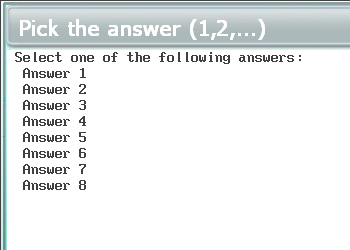


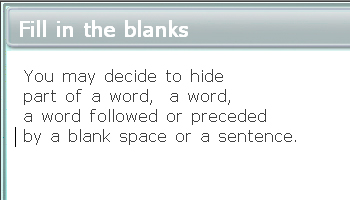







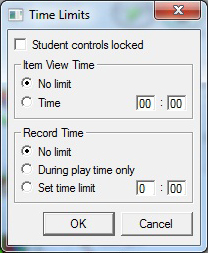

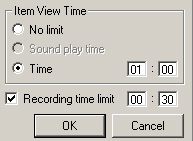

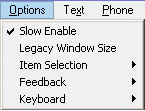




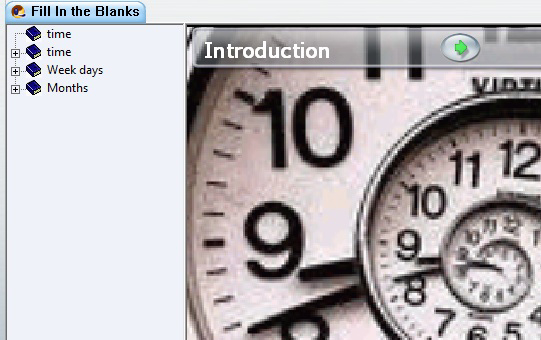




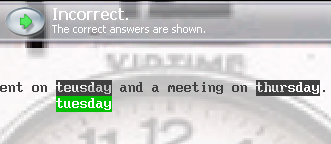
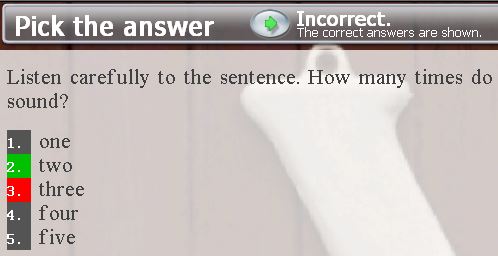

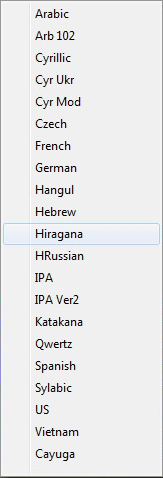
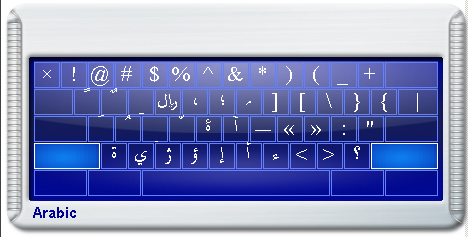
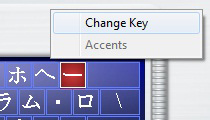
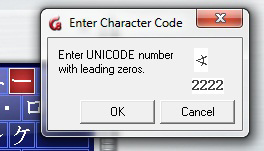


 Select the global save icon
Select the global save icon
